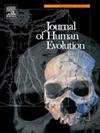Enhancing the reconstruction of the Gabasa Neandertal's diet using Ca and Sr stable isotopes
IF 3.1
1区 地球科学
Q1 ANTHROPOLOGY
引用次数: 0
Abstract
Neandertals are known to have occupied Eurasia for over 250,000 years and were well adapted to the environmental conditions of the last ice ages. However, the dietary habits of these ancient humans remain debated, with conflicting evidence suggesting that they may have been primarily carnivorous, omnivorous, or even herbivorous. Traditional isotope analyses have provided some insights into Neandertal diets, but their limitations (preservation and baseline effect) have sparked the need for new approaches. These limitations are well known on the Iberian Peninsula, and while recent results of carbon, oxygen, radiogenic strontium, and zinc isotopes and trace element ratios allow the reconstruction of the Gabasa (Spain) Neandertal diet, some questions still remain unanswered. Our study explores the potential of using calcium and stable strontium isotopes (δ44Ca and δ88Sr, respectively) to supplement previous analyses performed on the Gabasa Neandertal. Based on the low δ44Ca and δ88Sr values observed for the Neandertal specimen, our results suggest a hypercarnivorous diet that included low but non-negligible quantities of bone, although it is not possible to rule out the possible impact of milk consumption. Overall, our work argues that Ca, Sr, and Zn stable isotopes can supplement conventional isotope studies and offer a more comprehensive picture of human diets, including that of Neandertals.
利用Ca和Sr稳定同位素加强Gabasa尼安德特人饮食的重建
尼安德特人已经在欧亚大陆生活了超过25万年,并且很好地适应了最后一个冰河时代的环境条件。然而,这些古人类的饮食习惯仍然存在争议,有相互矛盾的证据表明,他们可能主要是肉食性的,杂食性的,甚至是草食性的。传统的同位素分析为尼安德特人的饮食提供了一些见解,但它们的局限性(保存和基线效应)引发了对新方法的需求。这些限制在伊比利亚半岛是众所周知的,虽然最近的碳、氧、放射性锶和锌同位素和微量元素比例的结果允许重建Gabasa(西班牙)尼安德特人的饮食,但一些问题仍然没有得到解答。我们的研究探索了使用钙和稳定锶同位素(分别为δ44Ca和δ88Sr)来补充先前对Gabasa尼安德特人进行的分析的潜力。根据在尼安德特人标本中观察到的低δ44Ca和δ88Sr值,我们的研究结果表明,尽管不能排除牛奶摄入的可能影响,但我们的研究结果表明,尼安德特人的饮食中含有少量但不可忽略的骨骼。总的来说,我们的工作认为Ca, Sr和Zn稳定同位素可以补充传统的同位素研究,并提供更全面的人类饮食图景,包括尼安德特人的饮食。
本文章由计算机程序翻译,如有差异,请以英文原文为准。
求助全文
约1分钟内获得全文
求助全文
来源期刊

Journal of Human Evolution
生物-进化生物学
CiteScore
6.30
自引率
15.60%
发文量
104
审稿时长
3 months
期刊介绍:
The Journal of Human Evolution concentrates on publishing the highest quality papers covering all aspects of human evolution. The central focus is aimed jointly at paleoanthropological work, covering human and primate fossils, and at comparative studies of living species, including both morphological and molecular evidence. These include descriptions of new discoveries, interpretative analyses of new and previously described material, and assessments of the phylogeny and paleobiology of primate species. Submissions should address issues and questions of broad interest in paleoanthropology.
 求助内容:
求助内容: 应助结果提醒方式:
应助结果提醒方式:


